最新人教版新目标初中英语七年级下册《Unit 10 第二课时(导学案)》精品获奖完美优秀观摩课赛教课导学单
- 格式:doc
- 大小:30.00 KB
- 文档页数:4
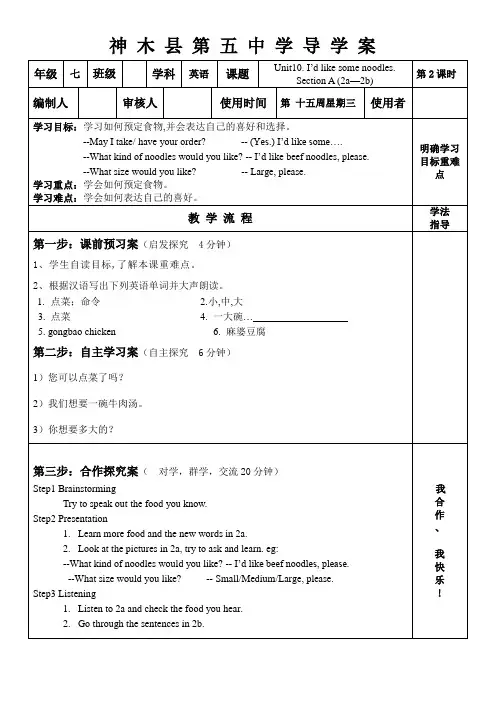


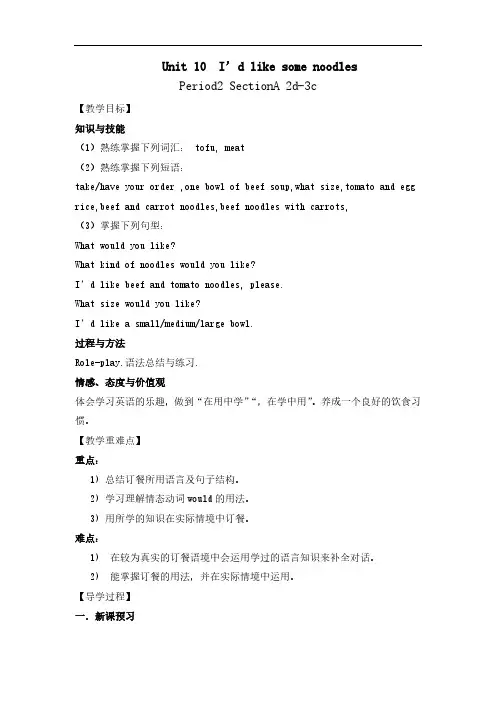
Unit 10 I’d like some noodlesPeriod2 SectionA 2d-3c【教学目标】知识与技能(1)熟练掌握下列词汇: tofu, meat(2)熟练掌握下列短语:take/have your order ,one bowl of beef soup,what size,tomato and egg rice,beef and carrot noodles,beef noodles with carrots,(3)掌握下列句型:What would you like?What kind of noodles would you like?I’d like beef and tomato noodles, please.What size would you like?I’d like a small/medium/large bowl.过程与方法Role-play.语法总结与练习.情感、态度与价值观体会学习英语的乐趣,做到“在用中学”“,在学中用”。
养成一个良好的饮食习惯。
【教学重难点】重点:1) 总结订餐所用语言及句子结构。
2) 学习理解情态动词would的用法。
3) 用所学的知识在实际情境中订餐。
难点:1) 在较为真实的订餐语境中会运用学过的语言知识来补全对话。
2) 能掌握订餐的用法,并在实际情境中运用。
【导学过程】一.新课预习①你想要什么面条? ______________________________________请给我来牛肉面。
________________________②你想要什么碗的?_______________________请给我来中碗的。
________________________________③你想来一个大碗吗? __________________________________好的。
______________________④在西红柿鸡蛋汤里有肉吗? _______________________________不,没有。
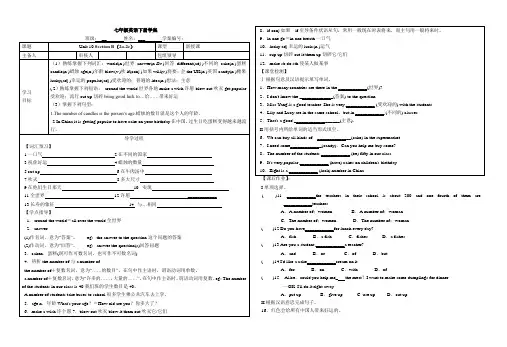
七年级英语下册学案班级:__ 姓名:___ 学案编号:【课后作业】:I.单项选择。
()11. ____________the teachers in their school is about 200 and one fourth of them are ____________teachers.A.A number of;women B.A number of;womanC.The number of;women D.The number of;woman()12.Do you have____________for lunch every day?A.fish B.a fish C.fishes D.a fishes()13.Are you a student ____________a teacher?A.and B.or C.of D.but()14.I'd like a cake____________cream on it.A.for B.on C.with D.of()15. --Alice,could you help me_ the meat?I want to make some dumplings for dinner.—OK. I'll do it right away.A.put up B.give up C. use up D.cut upII.根据汉语意思完成句子。
16.红色会给所有中国人带来好运的。
The red color will ________ ________ ________ ________ all the Chinese people. 17.如果你努力学习,你的梦想会实现的。
If you study hard,your dream will ________ ________.18.世界各地的人们都庆祝劳动节。
People ________ ________ ________ celebrate(庆祝) May Day.19.简的父母每年都为她订美味的生日蛋糕。
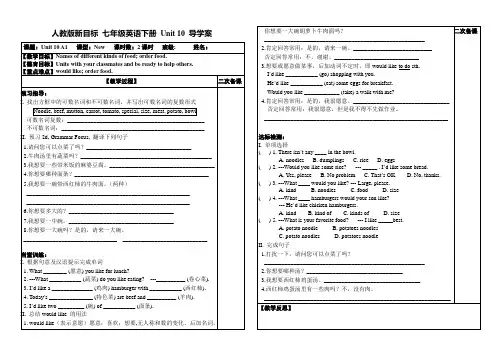
【教学目标】order food【德育目标】Unite with your classmates and be ready to help others.【重点难点】useful phrases and sentences【教学过程】二次备课预习指导:预习57、58俩页的内容,并写出下列短语:1.什么种类的面条_______________________2.牛肉面______________3.多大碗_____________________4.一大碗羊肉_________________5.西红柿鸡蛋汤________________________6.一些胡萝卜______________7.羊肉、胡萝卜面条______________________________________8.土豆沙拉____________________ 9.北街15号_________________10.12个羊肉胡萝卜饺子。
________________________________当堂训练:I. 可数名词与不可数名词专练1. How many ______________(碗) are there on the table?2. There are some __________ on the __________tree. (苹果)3. I’d like beef noodles with ____________(西红柿)I’d like beef and ___________noodles.4. Do you like ______________________(草莓)?5. Which kind of __________(水) would you like?6. In winter, I often drink ___________ soup to make me warm. (羊肉)In winter, I often drink soup with ___________ to make me warm7. She always eats ______________(冰激凌) after dinner.8. Would you like _________ _____________? (一份冰激凌)9. When the ______________ (鸡)grow up, they can make hamburgers with_______________(鸡肉)II. 完成下列句子1.西红柿鸡蛋汤里有肉吗?____ there ______ meat in the _________and _________ __________?No, _______________________ / No,____________________人教版新目标七年级英语下册Unit 10 导学案课题:Unit 10 B1 课型:New 课时数:2课时班级: 姓名:【教学目标】food tradition【德育目标】Unite with your classmates and be ready to help others.【重点难点】useful phrases and sentences【教学过程】二次备课预习指导:I. 预习并翻译下列短语和句子1.世界各地的生日食品____________________________________________2.人们吃插着蜡烛的生日蛋糕______________________________________3.蜡烛的数量_________________________________4.许个愿望并吹灭蜡烛______________________________________________5.愿望便会成真____________________________________6.在生日蛋糕里放一块糖_________________________________________7.吃到糖的那个孩子就是幸运星。
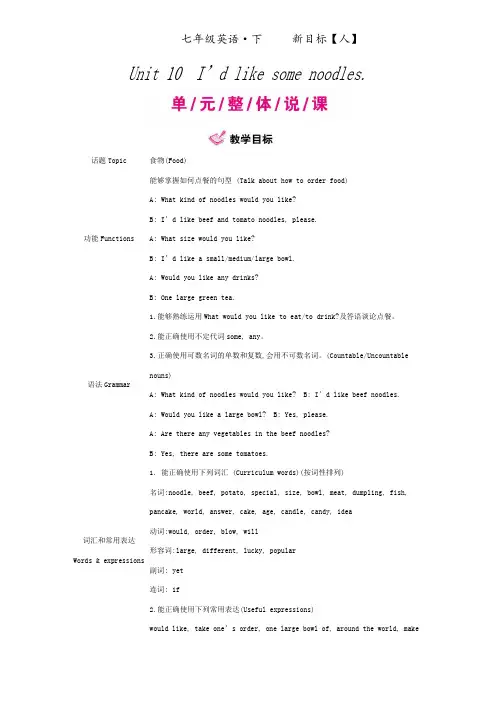
七年级英语·下新目标【人】Unit 10 I’d like some noodles.1.可数名词与不可数名词的区分。
2.点餐时的基本句型及交际运用。
3.some与any的运用。
4.培养学生从文章中获取细节,并进行归纳总结的能力,学生养成良好的阅读习惯。
以听说领先,在英语语境中大量感知和训练本单元的表示如何点餐的句型,养成良好的学习英语的习惯。
通过单元的语言学习,归纳总结如何点餐的句型以及可数名词与不可数名词的区分,使知识的记忆系统化。
采用Pair work和Group work相结合的方式,练习在饭店点餐的英文句型。
阅读活动设计为“读前、读中、读后”,每一步都设计了不同的任务或活动,重在培养学生的阅读策略和技能, 同时结合阅读材料进行拓展性语言训练和运用。
让学生在语言学习的过程中, 了解不同国家的饮食习惯。
教学突破:创设语境,重视听说能力,反复训练如何点餐。
在练习中正确使用What kind of …?注重方法与价值观的培养:以听说领先,结合图片的帮助在英语语境中大量感知和训练本单元的各种食物的名称和有关点餐的话题,学习would like的句型,养成良好的学习英语的习惯。
通过单元的语言学习,归纳总结would like句型、some和any的用法以及可数名词和不可数名词的语法知识,使知识的记忆形象化、系统化。
采用Pair work和Group work相结合的方式,练习点餐的英文句型。
通过大量的课堂练习,让学生对谈论饮食的话题感兴趣,并能运用所学的语言进行阅读写作练习,从语言学习的过程中,了解中西方饮食文化。
第一课时:Section A 1a-1c第二课时:Section A 2a-3c第三课时:Section B 1a-2c第四课时:Section B 3a - Self Check国外餐馆就餐礼仪在国外,一般的餐馆(非快餐性质)在门口均有带位员。
顾客进门后,带位员会首先问顾客同行有几位,然后带顾客入座。

Unit 10 Where did you go on vacat.The First Period (Section A 1a—1c)【学习目标】1 、掌握本节课单词2、能根据听力内容完成听力任务3 、能运用所学知识进行口语交际【学习重点】学习并掌握重点词汇【学习难点】学习一般过去时的句型(Where引导的特殊疑问句)【学法指导】1、能向小组成员用英语介绍生活中的日常活动,如:stay at home , go to the beach, do myhomework, watch TV, visit my uncle, go to New York, etc.2、运用一般过去时谈论过去的一天或一次旅行。
【学习过程】一、复习学生一起复习Unit 9的单词二、预习检测(1)预习指导A、预习P59的单词New York CityB、会读、会翻译la的短语C、你能说出一般过去式的变换规则吗?(2)预习检测A、试一试你能写出下列各词的过去式吗?stay_________ do_________ stop_________play_________ is_________ like_________visit_________ are________ carry_________B、快乐译一译stay at home go to summer campgo to New York city go to the mountainsvisit my uncle go to the beach三、自主学习任务一完成1a Match the activities with the pictures [a-g].任务二完成1b Listen and number the people [1-5] in the picture.任务三1c Groupwork(小组合作活动) 练习下列对话A: Where did you Tina go on vacation ?B: She went to the mountains .四、合作探究(一) Task 1、学生两人一组展示活动,轮流介绍自己去过的一个地方,如:I went to Beijing/ the Great wall /went to the park etc.Task 2、学生两人一组编对话讨论假期活动A:Where did you go on vacation? B:I went to the mountains.Task 3 运用la、lb内容编对话.(二)Where did… ? 是一段过去时的特殊疑问句,did是助动词,在一般过去时的句子中,在主语之前加did可构成疑问句,在主语之后,动词之前加didn’t可构成否定句,此时谓语动词用原形。
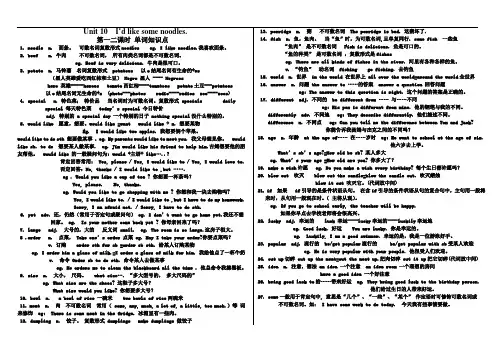
Unit 10 I’d like some noodles.第三四课时单词知识点some 用于疑问句时,表示建议、请求或希望得到肯定回答。
如:Would you like some coffee with sugar?你要加糖的咖啡吗?any 一般用于疑问句或否定句中, 意思是“任何一些”、“任何一个”, 作定语时可修饰可数或不可数名词。
如:They didn’t have any friends he re.他们在这里没有朋友。
any 用于肯定句时,意思是“任何的”. Eg. Come here with any friend. 随便带什么朋友吧。
28. the number of …….的数量。
后接复数名词,中心词为number,因此该短语主语时,谓语动词用单数。
eg. The number of students in our school is more than six thousand.我们学校学生数是6000多。
A number of许多的……. 。
做主语时,谓语动词用复数形式。
eg: A number of students in our school are friendly. 我们学校很多学生是友好的。
29. 名词:可数名词与不可数名词A、不可数名词,初中阶段常见的不可数名词有:water ; meat ; rice ; bread ; milk ; tea ;orange(桔汁) ; fruit ; air ; snow ; chalk; work ; paper(纸) ; time(时间); music ; weather ;grass ; news ; food ; fish(鱼肉); coke ; porridge ; cake(可数或不可数). 不可数名词应注意以下几点:1)前无数、冠,后无复数;作主语为三单.2)表量用约数some /any ; much ; a lot of 或用of短语eg. There is ____ bread on the table. [C]A. aB. oneC. a piece ofD. manyThere is some_______ on the plate. [B]A. appleB. fishC. milksD. deer2、可数名词的复数:A、不规则变化:man—men ; woman—women ;child—childrenpoliceman—policemenEnglishman—EnglishmenFrenchman—Frenchmenfoot—feet ; tooth—teeth mouse(鼠)—miceB、规则变化1)s; sh; ch; x 结尾加 es 读 [iz]2) ce; se; ze; (d)ge 结尾加 seg. boxes [b ksiz] blouses [blauziz]3)f (fe) 结尾则变f(fe)为v加es---读[vz]eg. knives [naivz] 4) “辅+y”结尾变y为i加es 清就清[s]5)一般加s 浊就浊[z]eg. books[buks] pens[penz] babies[beibiz]但注意以下几点:① potato—potatoes ; tomato—tomatoes②单复同形: fish ; sheep ; deer ; Chinese ; Japanese③由man , woman在词首构成的复合名词应将两部分都变成复数man doctor — men doctors④ reef—reefs⑤“某国人”的复数:中日不变英法变,其余s加后面. eg. German—Germans⑥ people , police 常用单数形式表示复数概念.eg. The police are looking for the missing boy.3、名词所有格:名词’s (意思是“……的”)A.有生命的名词所有格,一般在后加“’s”但注意:1)表两者共有则在后者加“’s”Lucy and Lily’s father 露西和莉莉的父亲Luc y’s and Lily’s fathers露西的父亲和莉莉的父亲.2)以s结尾的词只加“ ’ ”eg. 1) the boys’ books 2) James’ father3)无生命的名词所有格用of来引导eg. the leg of the desk4)双重所有格:a friend of my father’sa friend of mine ( √ ) a friend of my( × )练习:一、写出下列词的复数1.book______2.bus ____ __3.orange ___ ____4.baby__ ____5.boy__ ____6.my ____ ____7.his__ _____8.knife____ __9.watch______ __10.sheep ___ ___ 11. tooth __ ___12. leaf ___ _13.German___ _______ 14.Chinese_____ ____Unit 10 I’d like some noodles.orUnit 10 I’d like some noodles.自测一第十三课时一.根据首字母或汉语提示,写出单词。
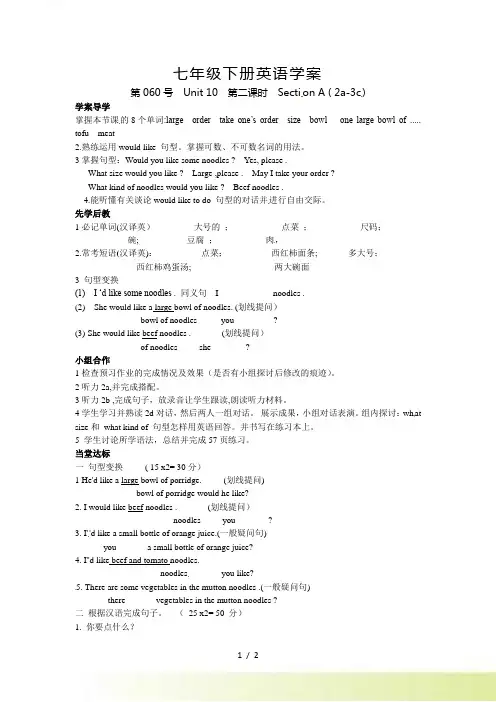
七年级下册英语学案第060号Unit 10 第二课时Secti on A ( 2a-3c)学案导学掌握本节课的8个单词:large order take one’s order size bowl one large bowl of ..... tofu meat2.熟练运用would like 句型。
掌握可数、不可数名词的用法。
3掌握句型:Would you like some noodles ? Yes, please .What size would you like ? Large ,please . May I take your order ?What kind of noodles would you like ? Beef noodles .4.能听懂有关谈论would like to do 句型的对话并进行自由交际。
先学后教1必记单词(汉译英)_________大号的;__________ 点菜;__________ 尺码;___________ 碗;___________豆腐;___________肉,2.常考短语(汉译英):__________点菜;__________西红柿面条;______ 多大号;______________西红柿鸡蛋汤;__________________ 两大碗面3 句型变换(1) I ‘d like some noodles . 同义句I _____ ______ noodles .(2) She would like a large bowl of noodles. (划线提问)_____ _____ bowl of noodles_____ you ________ ?(3)She would like beef noodles . (划线提问)_____ ______ of noodles ____ she _______ ?小组合作1检查预习作业的完成情况及效果(是否有小组探讨后修改的痕迹)。
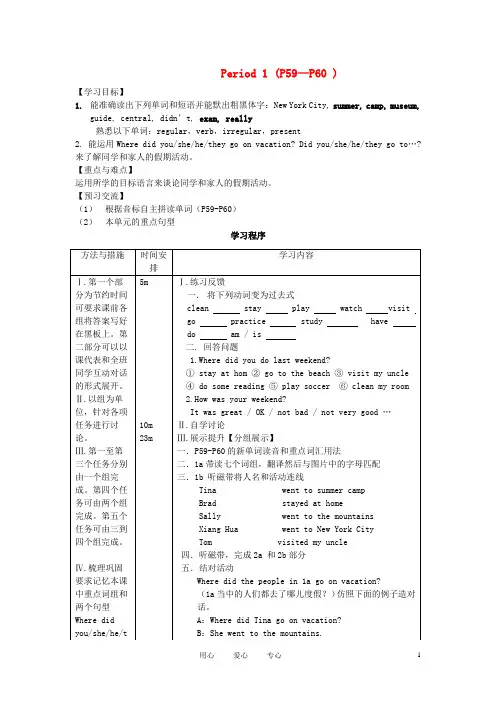
Period 1 (P59—P60 )【学习目标】1.能准确读出下列单词和短语并能默出粗黑体字:New York City, summer, camp, museum,guide, central, didn’t, exam, really熟悉以下单词:regular,verb,irregular,present2. 能运用Where did you/she/he/they go on vacation? Did you/she/he/they go to…?来了解同学和家人的假期活动。
【重点与难点】运用所学的目标语言来谈论同学和家人的假期活动。
【预习交流】(1)根据音标自主拼读单词(P59-P60)(2)本单元的重点句型学习程序Unit 10 Where did you go on vacation?Period 2 (P61)【学习目标】1.能准确读出下列单词并能用它们造句:rainy, were, fantastic, unfriendly, awful2.能运用下列句型来谈论过去的经历。
—How was your/his/her weekend? —It was great/ OK/ exciting.—What did you do/he/she last weekend? — On Saturday morning, I/he/she playedtennis.3.能自然流畅地运用一般过去时谈论过去的经历。
【重点与难点】重点:be+ 形容词。
难点:运用句型 How was/ were….?来询问对方度假的情况。
【预习交流】你能用rainy,were,fantastic,unfriendly,awful这些单词造句吗?学习程序Period 3 ( P62 )【学习目标】1.能准确读出并能用它造句:delicious ,expensive ,crowded ,cheap ,think of2.通过听力活动学会边听边做笔录,进一步提高听力技能。
班级小组姓名学号使用时间七年级英语下导学案编写人:备课组长:编写时间:5.14学科主任:_________ 编号:7102(47)课题:Unit 10 Where did you go on vacation?第二课时Section A 1a~2c学习目标: 1.会说会写会运用P61-62单词及短语:2..会用过去时态谈论假期感受How was your vacation ? It was great /terrible /Ok3. 学会使用过去时态的be动词am/is -----was are-----were )学习过程: Step1:会说会写会运用下列单词,短语。
1)单词:1下雨的________ 2.极好的_________ 3.不友好的_________4.极坏的________5.美味的_________6.昂贵的________7.拥挤的_______8.便宜的__________2)短语:1.你的假期______________________ 2.Step2:情境导入(填空,翻译,会读,会默写,会运用句型)A:How_________your vacation ?B:It _________great .A: How ___________the beaches? 3编写新对话B:They _________relaxing .A: Where ________you go ?B:I went to the US A. _______________________________________________________________________________________________________________________________________________________________________________________________________________ Step3:Practice1.学生组内换词练习对话:2.小组展示对话:3. 完成61页3a ,60页2cStep4:知识梳理。
Unit 10 I’d like some noodles.(导学案)第二课时(Section A 2a—2d)康平中学李艳芬【学习目标】:1) 能掌握以下单词:large ,order, bowl, size, tofu2)能掌握以下句型:①May I take your order?②— Can we have two bowls of beef soup then?— Sure. What size would you like?— Medium, please.3) 能进一步了解以下语法:情态动词would的用法;4)能掌握订餐或叫外卖等的用语。
【学习重点】1)能够正确使用英语点餐的句型:--What kind of noodles would you like?-- I'd like the beef noodles, please.2) 引导学生们做听、说的训练。
【体验学习】:预习交流一:英汉互译:1. 想要,喜欢_________________2. 牛肉面____________________ 4. 鸡肉_____________________ 5. 羊肉______________________3. 卷心菜___________________ 6. 胡萝卜_____________________ 7. 土豆(复数) _______________ 8. 西红柿(复数) _______________ 9. special ___________________ 10. 我还没想好。
_______________ 11. large 12.order13. bowl 14. size15. tofu【课堂导学】:1、复习上节课内容2、教学2a (1)认识食物以及食物的名称(2)听力,勾出听到的食物名称教师和学生一起来确认答案。
3、教学2b 再听听力,完成填空4、教学2c 编写新对话5、教学Role-play【自主检测】:一、根据句意及汉语提示完成句子1. I’d like some beef and____(西红柿)noodles.2. How many______(土豆)would you like?3. He’d like a_____ ______(小碗)of dumplings.4. A_____(大号)bowl of rice, please.5. We have some______(特色菜)today.二、单项选择题1、Can I help you? -______.A. That’s goodB. OK, I’ll take it.C. Yes, I’d like a sweaterD. It’s too dark.2、Would you like______?A. some juiceB. any juiceC. some juicesD. any juices3、-What____ of noodles do you want?-Carrot and beef noodles, please.A. sizeB. kindC. bowlD. \4、-Would you like some bread? -________.A. No, I wouldn’tB. That’s all rightC. Yes, pleaseD. Yes, I would5、Today’s special is just_____15 dollar s.A. ofB. onC. forD. at___________________________________________________________ 【学习体会】成功&收获: 失败&不足:。
Unit10 I’d like some noodles. Section A执笔: 魏朝明审核:林艳张杏娟李俊辉【学习目标】1.新词汇及拓展运用2.关于食物方面的单词,哪些是可数,哪些是不可数,哪些既是可数又是不可数3.餐馆文明点餐用语及服务员文明服务用语【预习导学】1.根据读音规则拼读新单词,在不会的单词下做标记,向同学老师请教2.完成下列短语a) 三个西红柿___________b) 一些鸡肉___________c)第一道特色菜________d)一碗面条___________ e) 大/中/小_____________ f) 什么尺寸____________3. 完成句子a)你想要哪种面条?What ______ _____noodles _______you ______?b)你想要什么尺寸的?_______ _______would you like ?c)你们有什么尺寸的?What _____ ______you _______?d)我想要西红柿牛肉面。
I’d like_______and _______noodles, please.e)您可以点菜了吗? May I ______ _______ ________?【自主探究】观察:two banana trees three shoe shops four women doctors思考:哪种情况前面一个名词用复数,哪种情况不用复数?________________________________________________________________________________ 快乐尝试:A bowl of _______ _________ (牛肉汤)Five bowls of__________ __________(西红柿面条)A bowl of _________with ________(西红柿面条)Thirteen ___________ ___________(男教师)【课堂活动】1.自学情况交流:小组交流自学中存在的问题(老师点拨)2.学习策略培养:1)口语训练:----What would you like ?----I’d like…----What kind of noodles would you like?----I’d like …noodles----What size would you like?----I’d like a large/medium/small bowl, please.---Is there any …?----Yes , there is. / No, there isn’t.2)听力策略培养(1b,2a&2b)3)口语策略培养2d, 3a. 小组训练对话1.成果展示模拟餐馆场景,演扮服务员waiter/waitress与顾客customer,编写一段对话,包揽今天所学内容,然后表演。
前言:
该导学案(导学单)由多位一线国家特级教师根据最新课程标准的要求和教学对象的特点结合教材实际精心编辑而成。
实用性强。
高质量的导学案(导学单)是高效课堂的前提和保障。
(最新精品导学案)
Unit 10
第2课时Section A (2d-3d)
教师寄语:You can't judge a tree by its bark. 人不可貌相。
学习目标:
1、与食物相关的各种词汇,;
2、总结归纳并学会运用Section A部分知识重点;
3、能分辨并正确使用可数名词及不可数名词。
学习重难点:
点餐时常用的句型和不定代词some和any的用法。
What kind of dumplings would you like? I’d like…
课前储备:
英汉互译:
1.两碗米饭___________________
2.一些鸡肉_____________
3.beef and tomato noodles _______________
4.I’d like some noodles. _____
5.a small bowl of noodles_______________
6.一大碗牛肉汤__________
7.chicken, potato and cabbage noodles _________________
8,____________________
热身练习:
--What would you like? -- I'd like …
--What kind of …would you like? -- I'd like ...
自主学习:
Task1.自学Role-play,回答问题:
a)What would Sally and Tom like to eat? ___________________________
b) How many bowl of soup would Sally and Tom like to have? _______________________________________
c) What size would they like? ___________________________
Task 2.完成3a-3c的任务
合作探究:
根据Grammar Focus, 梳理总结Section A部分知识重点;
would like的用法(2)
一般疑问句与特殊疑问句:
句式一:陈述句变一般疑问句,把情态动词移到句首, I变为you。
eg: I would like some milk.. Would you like some milk?
注意:其中的some 没有变成 any 是因为句子表达的是“要求,请求,提供需要”的意思,在这种情况下,句中的some 不需要变成any
句式二:陈述句变成否定句 eg: I would like some milk. I。